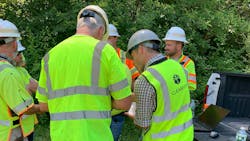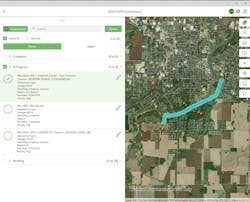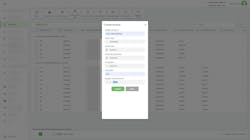Streamlining Utility Vegetation Contractor Management
For utilities today, implementing technology for vegetation management is a bit like the adage about “building the plane while it’s flying.” Manual and paper processes persist, and where technology has been adopted, it’s frequently dispersed over several individual “point solution” applications that are poorly integrated, if at all.
But nothing stops growing. Utilities can’t press pause on maintaining vegetation for safety and reliability while trying to improve processes. And, as the frequency and severity of emergency response scenarios grows, that work increases in quantity and complexity.
Despite these challenges, the work continues, mostly handled by contractors versus full-time contract arborists and utility employees (native crews). However, managing contractors, long considered “external” resources, alongside native crews, thought of as “internal” resources, has become one of the biggest disconnects.
To better understand how utilities could manage contractors as easily as native crews, it’s important to take a deeper look at the digital transformation of utility operations, particularly automated workflows and mobile optimization. Where have we been and where does the industry stand today?
Where We’ve Been
In our view, one of the biggest challenges facing utilities today is managing contractors alongside native crews. We have seen the utility workforce for executing vegetation management projects become outsourced almost entirely to contractors, which execute vegetation management project work on the front lines.
When existing processes are slow and disjointed, it can delay job completion, putting utility infrastructure at higher risk when unplanned events or major emergencies occur. Delays also impact customer satisfaction — when service jobs aren’t completed in a timely manner, it leads to unhappy customers. With poorly optimized processes, work can become reactive and short-term, with poor data to inform planning and no time to build out long-term vegetation programs.
Fortunately, advancements in purpose-built digital vegetation work management tools are helping contractors get more work done safely and more accurately. Digital work management extends automated workflows across the teams needed to get jobs done. These tools give back-office operations and crews in the field visibility into jobs via mobile devices and connect all necessary personnel in a single real-time process.
Access to information expedites communication, which is fundamental to executing work more quickly and maintaining high customer satisfaction. Digital processes also empower utilities to capture rich data about vegetation activities, crew location, activity, hours worked and more — all of which contribute to more effective long-term planning. With tight GIS integration, that data connects to precise locations, allowing for detailed tracking of vegetation growth by location over time.
Where We Are
For utilities willing to embrace digital transformation, digital work management has provided great benefits in the tactical execution of vegetation management projects. Today, some utilities and their contractor partners are exploring the next stage of digital evolution. While digital transformation is well worth the effort from a tactical perspective, it also offers significant value for business strategy development, both for the utility and the companies employing the contractors.
In large part, this shift involves improved visibility. More detailed data and improved workflows give contractor companies a clearer view into key aspects of operations. Consider digital timesheets — ultimately, contracting companies that collaborate with utilities in a work management system get paid more quickly and accurately.
With digital work management on the devices of each contractor crew in the field, it’s easier to capture rich data on when crews start, when they wrap and what they’ve worked on. Digital work management platforms match exact hours worked with jobs completed, which eliminates manual auditing and helps track necessary rework more effectively. For the utility, digital timesheets reduce errors in billing, which can result in cost savings over time.
Another example is digital invoicing, in which unit-based contracts allow contractor companies and their utility customers to track work at the level of individual tasks. The workflow might look something like this:
- Pre-planned line clearing work is dispatched digitally to crew leaders who mark work complete and document exceptions.
- One or more audit steps are completed digitally with re-work instructions automatically routed to the right crew leader and field supervisor.
- Digital invoices are generated in the vegetation work management software based on work completion and quality.
- Invoice approvals occur far faster because work tasks have already been audited and approved.
With secure, web-based access to invoice status, contractors can monitor the status of invoices, reducing time-consuming communication for both the contractor back-office staff and the utility program administrators.
Where We’re Going
Ultimately, the potential for digital transformation in vegetation and contractor management is merely a starting point. Imagine having this level of detail about work and people, and for all grey-sky and blue-sky work and crews. Suddenly any contractor who works with the utility has the same visibility and benefits. This would be transformative for mutual aid crews during emergency response.
By bringing contractors and native crews, daily operations and emergency response together in a single real-time view, utilities could improve scheduling with higher awareness of a worker’s availability to take on new jobs. They could gain real-time visibility into where crews are working and deploy crews as needed to address unplanned outages. With a click, utilities could transition into major emergency response activities and then back to daily operations when the emergency is resolved.
Utilities are already starting down this path and realizing some of the broader benefits of digital transformation. For example, digital transformation gives utilities an advantage when it comes to recruiting and retaining highly skilled workers. As a generation of crew workers retires, younger counterparts have expectations that technology will work seamlessly alongside them. At some point, choosing point solutions to solve specific needs results in “app proliferation,” where workers and their leaders are forced to use several applications to manage a single process. On the contrary, a single work and people platform brings those functions together in one place, reducing the cost and effort required to maintain solutions.
It’s possible that managing work and people in vegetation management (or any other area of utility operations) will always feel a bit like building a plane while it’s flying. With the right digital tools, it suddenly becomes a lot easier to pilot that plane toward the right destination — providing safe, efficient and reliable resources to your constituents.
About the Author
Chris Kelly
Chris Kelly is the CEO of Clearion.



